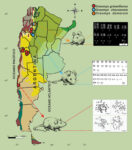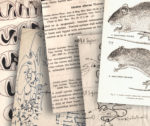Karyotypic diversity of the genus Graomys Thomas, 1916 (Rodentia, Cricetidae, Sigmodontinae)
Romina V. De Cena, Carolina A. Labaroni, Juan J. Martínez, Diego Baldo, Ignacio Ferro, Agustina A. Ojeda, Daniela Rodriguez, Cecilia LanzoneThe genus Graomys contains four species and presents significant karyological diversity. Graomys griseoflavus, inhabiting mainly the Monte Desert ecoregion, shows variations in diploid number (2n) from 33 to 38 due to Robertsonian translocations and in fundamental number of autosomal arms (FNa) from 44 to 48 due to inversions. Graomys chacoensis, which occurs in the ecoregions of the Chaco and the Espinal, has 2n = 42 and FNa = 44–46 due to a pericentric inversion. Graomys domorum, which inhabits the Yungas ecoregion and the Yungas-Chaco transitional zones exhibits 2n = 28 and FNa = 46, but its karyotype is known only by a schematic representation for two specimens from Bolivia. The karyotype of G. edithae has not yet been described. In this report, we studied 29 individuals of the three former species from different localities of their distribution, using conventional and differential cytogenetic techniques and chromosome measurements. In G. griseoflavus, we have identified the pairs involved in the three Robertsonian translocations, supporting an independent, not sequential origin of this polymorphism. The nearby area of Mendoza City showed the greatest chromosomal diversity for G. griseoflavus. The banding pattern associated with the chromosomal measurements allowed us to suggest the possible pairs involved in the pericentric inversions of G. griseoflavus and G. chacoensis. The presence of heterochromatin indicates more significant chromosomal variability and complexity than previously recognized. The chromosome complements of G. chacoensis and G. griseoflavus are more similar to each other. The karyotype of G. domorum from Argentina differs from the previously reported from Bolivia, and is the most divergent within the genus.
Diversidad cariotípica en el género Graomys Thomas, 1916 (Rodentia, Cricetidae, Sigmodontinae). El género Graomys contiene cuatro especies y presenta una diversidad cariológica significativa. Graomys griseoflavus habita en la ecorregión del Desierto del Monte y muestra variaciones en el número diploide (2n) de 33 a 38 debido a translocaciones robertsonianas, y en el número fundamental de brazos autosómicos (FNa) de 44 a 48 debido a inversiones. Graomys chacoensis se encuentra en las ecorregiones del Chaco y el Espinal, y tiene 2n = 42 y FNa = 44–46 debido a una inversión pericéntrica. Graomys domorum habita en la ecorregión de Yungas y en zonas de transición con el Chaco, y exhibe 2n = 28 NFa = 46, pero su cariotipo sólo se conoce por una representación esquemática para dos especímenes de Bolivia. El cariotipo de G. edithae no ha sido descrito. En este trabajo estudiamos 29 individuos de las tres primeras especies distribuidos en diferentes localidades, utilizando técnicas citogenéticas convencionales, diferenciales y mediciones cromosómicas. En G. griseoflavus identificamos los pares involucrados en las tres translocaciones Robertsonianas, apoyando un origen independiente, no secuencial de este polimorfismo. El área cercana a Mendoza alberga la mayor diversidad cromosómica de G. griseoflavus. El patrón de bandas y las medidas cromosómicas nos han permitido sugerir los posibles pares involucrados en las inversiones pericéntricas de G. griseoflavus y G. chacoensis. La presencia de heterocromatina indica variabilidad cromosómica adicional y una mayor complejidad de lo que se reconocía previamente. Los complementos cromosómicos de G. griseoflavus y G. chacoensis son muy similares. El cariotipo de G. domorum de Argentina difiere del informado en Bolivia y es el más divergente dentro del género.

